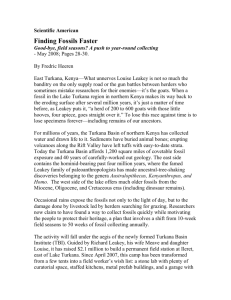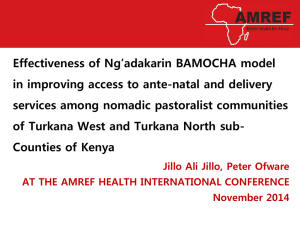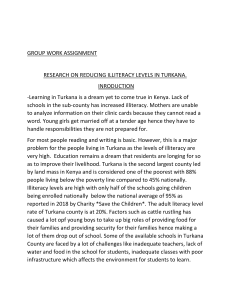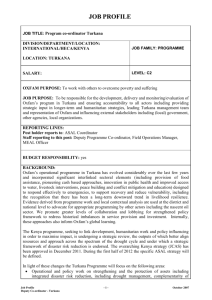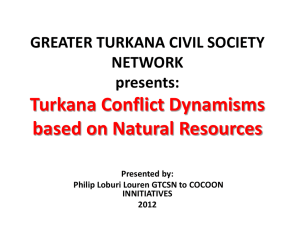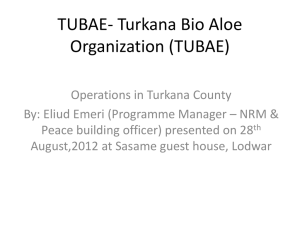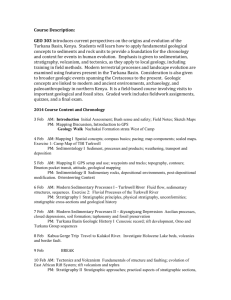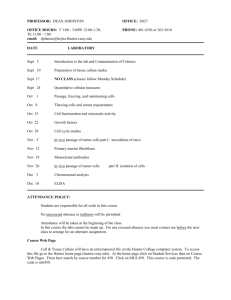Exploring the Human Past
advertisement
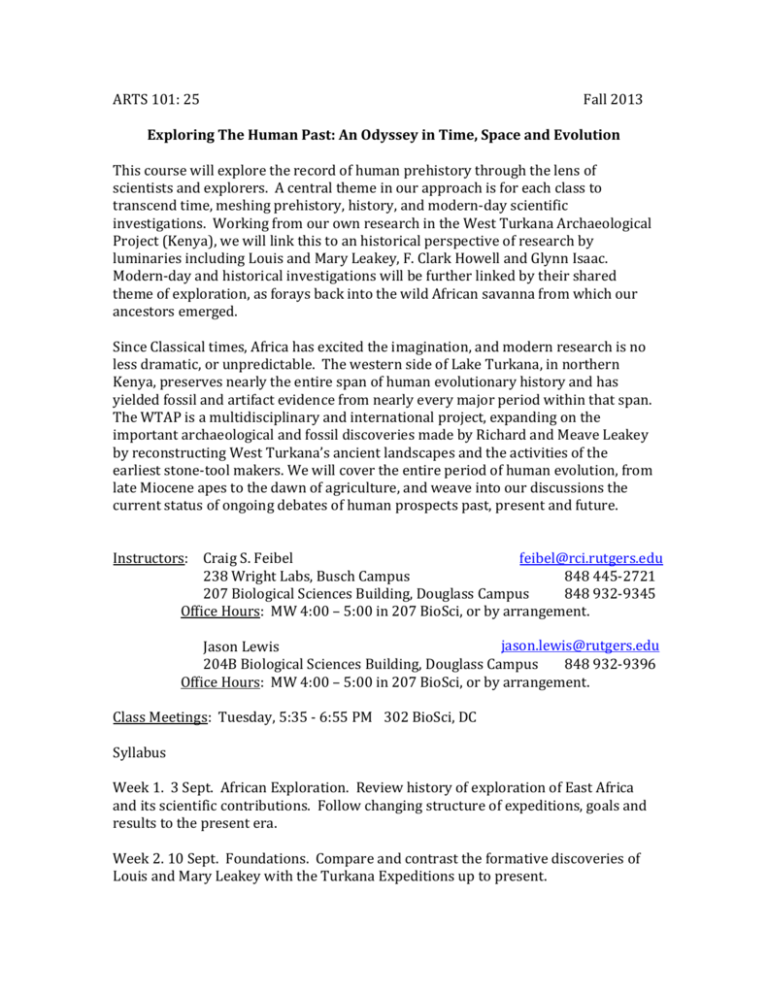
ARTS 101: 25 Fall 2013 Exploring The Human Past: An Odyssey in Time, Space and Evolution This course will explore the record of human prehistory through the lens of scientists and explorers. A central theme in our approach is for each class to transcend time, meshing prehistory, history, and modern-day scientific investigations. Working from our own research in the West Turkana Archaeological Project (Kenya), we will link this to an historical perspective of research by luminaries including Louis and Mary Leakey, F. Clark Howell and Glynn Isaac. Modern-day and historical investigations will be further linked by their shared theme of exploration, as forays back into the wild African savanna from which our ancestors emerged. Since Classical times, Africa has excited the imagination, and modern research is no less dramatic, or unpredictable. The western side of Lake Turkana, in northern Kenya, preserves nearly the entire span of human evolutionary history and has yielded fossil and artifact evidence from nearly every major period within that span. The WTAP is a multidisciplinary and international project, expanding on the important archaeological and fossil discoveries made by Richard and Meave Leakey by reconstructing West Turkana’s ancient landscapes and the activities of the earliest stone-tool makers. We will cover the entire period of human evolution, from late Miocene apes to the dawn of agriculture, and weave into our discussions the current status of ongoing debates of human prospects past, present and future. Instructors: Craig S. Feibel feibel@rci.rutgers.edu 238 Wright Labs, Busch Campus 848 445-2721 207 Biological Sciences Building, Douglass Campus 848 932-9345 Office Hours: MW 4:00 – 5:00 in 207 BioSci, or by arrangement. jason.lewis@rutgers.edu Jason Lewis 204B Biological Sciences Building, Douglass Campus 848 932-9396 Office Hours: MW 4:00 – 5:00 in 207 BioSci, or by arrangement. Class Meetings: Tuesday, 5:35 - 6:55 PM 302 BioSci, DC Syllabus Week 1. 3 Sept. African Exploration. Review history of exploration of East Africa and its scientific contributions. Follow changing structure of expeditions, goals and results to the present era. Week 2. 10 Sept. Foundations. Compare and contrast the formative discoveries of Louis and Mary Leakey with the Turkana Expeditions up to present. Week 3. 17 Sept. Frameworks. Develop global and regional context in time, environment and history of the African savanna. Week 4. 24 Sept. An Evolving Clade. Develop the record of evidence for human evolution through discoveries, analysis, controversy and theories. Week 5. 1 Oct. Recorded in Stone. The archaeological record: ancient evidence, modern interpretations and rediscovering ancient technologies. Week 6. 8 Oct. Primate Perspectives. From genetics to behavioral ecology, how primates inform us. Field studies, habitat interactions, and reconstructing paleoecology. Week 7. 15 Oct. Savanna Landscapes. Environmental dynamics and terrestrial ecosystem interactions, working from basinal to habitat scale. Week 8. 22 Oct. Adaptive Legacy. The interplay between heritage and adaptation in the development of humans within the savanna setting. Week 9. 29 Oct. Food Economy. Changing dependencies of human populations through the agricultural revolution. Specific focus on Turkana pastoralists, fishing societies, and their environmental interactions. Week 10. 5 Nov. The Future. New Frontiers, the changing face of exploration and scientific challenges in a rapidly changing world. The threatened legacy of the Turkana Basin with Ethiopian dams, sugar plantations and exceeded carrying capacities. Readings Brown, L. 1979. Encounters with Nature. Oxford University Press, Oxford. 194 pp. Chapter 1 “Threads of Experience”. von Höhnel, L. 1894. Discovery of Lakes Rudolf and Stefanie: A narrative of Count Samuel Teleki's exploring and hunting expedition in eastern Equatorial Africa in 1887-1888. Longman's and Green, London. Excerpts Lewin, R. 1987. Bones of contention. Simon and Schuster, New York. 348 pp. Chapters 3 & 4 “The KBS Controversy”. Feibel, C. S. 2011. A Geological History of the Turkana Basin. Evolutionary Anthropology 20(6): 206-216. Bell, R. 1992. Impure Science. J. Wiley & Sons, New York. 301 pp. Chapter 1 “Shortchanged” Assignments Week 4. Assignment: Film Critique. Compare and contrast segments of the films Mountains of the Moon and Bones of Turkana. Complete background notes/discussion worksheet; class discussion of changing perspectives on exploration, scientific method, personalities and culture. Week 7. Data Analysis. Group development of habitat-specific community analysis for Pliocene Turkana Basin faunas. Field Trips Week 3. Lamont Columbia Core Repository. Visit and examine marine core archives of environmental change, with focus on African responses to Ice Age climate dynamics. Hosts Professors Peter deMenocal and Maureen Raymo. Week 5. University of Pennsylvania Museum of Archaeology. Guided tour of Human Evolution exhibit by its creator, Dr. Janet Monge. Behind the scenes tour of collections of fossil and modern specimens, and confront problems in morphology, variation, and identification. / Philadelphia Zoo. Visits to their ‘African Plains’ and ‘Primate Preserve’ exhibits, to solidify classroom discussions and learning.
